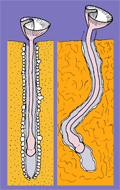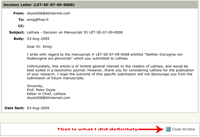
 
Dilemma 2
Tribulations of a manuscript…
from Lethaia to Acta Palaeontologica Polonica
"Indifference: the worst of the attitudes.
It is true, the reasons to be indignant can appear
today less clear or the world too complex"
(in "Indignez-vous !" from Stéphane Hessel)
When reading the paper of Bassett et al. (2004), I found a reference to MacKinnon & Biernat (1970) in which the ichnogenus Diorygma atrypophilia is considered to be the trace of a phoronid, although the title of their paper does not so state. The two authors attribute the borings to a Palaeozoic phoronid in brachiopod shells, and propose a hypothesis for their construction which is not compatible with the body plan of the Phoronida.
This erroneous interpretation was published in the highly regarded journal Lethaia, a Scandinavian scientific journal, so despite its age and the paucity of other citations (about 1-2 per annum, in the last decade), it appeared necessary to demonstrate that Diorygma-borings cannot be attributed to phoronids.
A two-page manuscript, destined for the Seminars section, was sent to Lethaia in the hope that its editors would recognize that their judgement in publishing this 1970’s paper had been faulty. And at that time, there had been three excellent specialists in Phoronida: Lars Silén, at the University of Stockholm, also well-known for his work on Bryozoa, Russel Zimmer in California and myself in Marseille. But in that era Biology and Palaeontology were discrete disciplines with hermetically sealed borders.
The contribution was posted July 27, 2009. A negative response was received on August 3rd. - without right of appeal! - see facsimile. An email exchange told me that Lethaia is a trade journal, with its limited space reserved for prestigious works. Consequently, the rectification of an erroneous attribution made 40 years ago was not worth publishing, although the scientific revelance of a correction had not lessened. Duly registered!
I conclude that even in the internet era business and science remain incompatible. This should not discourage anyone from submitting a manuscript or being a referee for Lethaia, but does require an appropriate remuneration! Doing business one must pay for raw material and duty.
After this episode unflattering for Science and ethically reprehensible, in August 2009 I sent a revised somewhat enlarged version of the manuscript to Acta Palaeontologica Polonica to appear in the section Brief reports.
[The original description of Diorygma atrypophilia was published by Biernat (1961) in this journal].
Reviewers comments were sent me in November 2009. Two reviewers, one a specialist on brachiopods, the other on phoronids, made brief remarks and suggested some changes in the text. A third reviewer, anonymous, was cutting: "so, yes, it might be somewhat naïve to interpret these structures as having anything to do with phoronids", a view not shared by the authors citing the work for 40 years (1), but what gave him the authority to insult these colleagues. He adds "the manuscript is not acceptable for publication in its current form". Finally, "the figures are scanned in copies of original figures from Biernat (1961) and MacKinnon and Biernat (1970). This is unnecessary - text-reference to the original figures would suffice". The editor confirmed his opinion "republication of the illustrations is unnecessary".
The changes suggested by the reviewers were made, the concerned figures removed and a new version sent in December 2009. On January 12, 2010 the editor announced that he would decide on publication in a few days.
A manuscript concerning the same subject as that of my submittal was sent by Balinski & Sun
to Acta Palaeontologica Polonica on April 6, 2010.
The manuscript accompanied by the comments of two new anonymous referees reached me only early in May. The editor wrote: “we are aware that this extends the evaluation process but we agreed with the referees that such improvements are essential prior publication of your paper. If you feel that you can adjust your MS according to the referes' (sic) suggestions then send me back the new version of the MS in a due time”.
The first referee wrote: “it is necessary for Emig to illustrate his short critique, not only with reproductions of MacKinnon & Biernat's figures, but also preferably figures showing the crucial metamorphosis in modern phoronids”. Then, “in the case of the inferred phoronid boring Talpina, Voigt has demonstrated a good match with the borings of Recent Phoronis ovalis” – of course, but the referee was unaware that this study a joint effort, published after several years of letter exchanges - in German - with Ehrhard Voigt, as reported in Emig (1982).
The second referee wrote: “I appreciate the author’s viewpoint, as a phoronid expert, and I’m willing to accept his anatomical arguments against the phoronid-Diorygma link are correct... although, I am not familiar enough with phoronid anatomy to evaluate his specific arguments". Then, “the author has unique expertise to critically evaluate the supposed phoronid affinity of particular trace fossils. This could be a significant contribution to ichnology and I encourage the author to consider expanding this manuscript to include Talpina and provide figures to illustrate the anatomical attributes of phoronids as they relate to trace fossil cavities”. That is a departure from the initial aim for I am a biologist, neither palaeontologist nor ichnologist! A third draft of the manuscript was prepared, conforming with the latest suggestions, including the reinstatement of the figures, and was sent to Acta Palaeontologica Polonica at the end of May 2010 .
Acceptance of the manuscript of Balinski & Sun on 1st September 2010 by Acta Palaeontologica Polonica.
In the Fall, after several reminders had been sent to Acta, the manuscript came back - finally – on 18 November with a new set of comments made by the two previous referees, but they had been transcribed and transmitted by the editor in an email! The remarks took an unpleasant turn, the reason for which will appear at once . For example: "there is need to restudy the material of Diorygma, that should be coupled with a comparison with extant phyla to infer to which of these it is most closely related. The concepts of stem- and crown-groups would be highly relevant here". More "how can fossil phoronids be recognized in author's view: what are the diagnostic features of modern phoronid borings and burrows that might be applied to putative fossil examples?" But the manuscript answers this question. And finally "Our overall opinion is that while the revised version of your manuscript is an improvement on the original, it cannot be accepted without further extensive work". It's amusing to note that eight days later another editor of Acta Palaeontologica Polonica wrote: "I’m looking forward to read the new version of your manuscript!" Who is making fun of who?
So my decision was made to review the manuscript for submission to another journal, Carnets de Géologie / Notebooks on Geology. While looking for a paper on Diorygma I discovered in Acta Palaeontologica Polonica the following preprint:
Balinski A. & Sun Y. Tubular shell infestations in some Mississippian spirilophous brachiopods. Acta Palaeontologica Polonica in press available online 13 Sep 2010.
[Nota: there is an error in the title - the correct term is spirolophous and not spirilophous.]
I was astounded to see in this work a part of my manuscript. The publication of Balinski & Sun is annotated : "Received 6 April 2010, accepted 1 September 2010, available online 13 September 2010". Note that Andrzej Balinski is a colleague working on brachiopods. I know him personally. But he is also the Production Manager of the Publishing department of Acta Palaeontologica Polonica! In order to retain recognition for my work I requested fast publication for my manuscript in Carnets de Géologie / Notebooks on Geology, where it was issued November 30, 2010, under the title Fossil Phoronida and inferred ichnotaxa.
|
Emig C.C., 2010. Fossil Phoronida and inferred ichnotaxa. Carnets de Géologie - Notebooks on Geology, Letter 2010/03 (CG2010_L03), 5 p., 4 figs.
HTML - PDF
|
|
Balinski A. & Sun Y., 2010. Tubular shell infestations in some Mississippian spirilophous brachiopods. Acta Palaeontologica Polonica, 55 (4), 689-694.
HTML - PDF
|
Please feel free to download both publications to get an idea of what obviously is unethical behaviour by the editorial board of Acta Palaeontologica Polonica, and to a slightly lesser degree by the editor of Lethaia. Only the reader can decide what should be done.
- Nota: For a better comprehension of the motives for this disgraceful act, I must mention that I made two trips to the Instytucie Paleobiologii in Warsaw (Poland), which publishes Acta Palaeontologica Polonica. I know a number of the researchers there and have coauthored with two of them. I have had a cooperation on brachiopods with them for over 20 years and my next visit is planned in 2012. Furthermore an important part of my collection of brachiopods has been registered there.
PS: From the publication of Balinski & Sun (2010):
"Later, however, McKinnon and Biernat (1970) suggested a probable phoronid relationship, pointing out that U-shaped tubes of Diorygma reflect the similarly shaped digestive tract of phoronids. This seems unlikely as phoronids are elongated worm−shaped animals having just U−shaped digestive tract, not their body (see also Emig http://paleopolis.rediris.es/Phoronida/SYST/PHORONIDA/Pho-FOSSIL/Diorygma-Eodiorygma.html)".
For the same reference the editor of Acta Palaeontologica Polonica wrote in my manuscript the following comment: “the website is not peer reviewed and therefore has the potential to be highly selective” (sic).
It would be interesting to have the opportunity to compare all the comments on my manuscript with those received by A. Balinski on his paper Balinski & Sun, 2010. Tubular shell infestations in some Mississippian spirilophous brachiopods. Acta Palaeontologica Polonica, 55 (4), 689-694.
|



